
<< Back | Home | Site Map
SAFEWORKING SYSTEMS
Train Staff and Ticket Sections:
1903-1904 Woomelang - Hattah; Hattah - Mildura;
1904-1909 Woomelang - Mildura;
1909-1911 Woomelang - Ouyen; Ouyen - Mildura;
1911-1912 Woomelang - Lascelles; Lascelles - Ouyen; Ouyen - Hattah; Hattah - Irymple; Irymple - Mildura;
1912-1914/15 Woomelang - Lascelles; Lascelles - Speed; Speed - Ouyen;
1914/15-1919 Hattah - Irymple; Irymple - Mildura;
1919-1922 Hattah -Yatpool; Yatpool - Irymple; Irymple - Mildura;
1922-1924 Hattah - Yatpool; Yatpool - Red Cliffs; Red Cliffs - Irymple; Irymple - Mildura;
1924-1925 Hattah - Carwarp; Carwarp - Redcliffs; Red Cliffs - Irymple; Irymple - Mildura;
Large Electric Staff Sections:
1914/15-1957 Woomelang - Lascelles; Lascelles - Speed; Speed - Ouyen; Ouyen -Hattah;
Miniature Electric Staff Sections:
1925-1989 Hattah - Carwarp; Carwarp - Redcliffs; Red Cliffs - Irymple; Irymple - Mildura;
1957-1982 Woomelang - Lascelles; Lascelles - Speed;
1982-1989 Woomelang - Speed;
Train Order Locations:
1989-1992 Woomelang - Speed; Speed - Ouyen (also Intermediate Terminal Station); Ouyen - Hattah; Hattah - Carwarp; Carwarp - Redcliffs; Redcliffs - Irymple; Irymple - Mildura (Terminal Station).
1992 -1997 Woomelang - Gama Block Point; Gama Block Point - Speed Loop; Speed Loop - Ouyen; Ouyen - Hattah; Hattah - Carwarp Loop; Carwarp Loop - Yatpool Block Point; Yatpool Block Point - Irymple; Irymple - Mildura.
Section Authority Working:
1997-1999 Woomelang Unattended Crossing Loop - Gama Block Point; Gama Block Point - Speed Loop; Speed Unattended Crossing Loop - Ouyen Intermediate Terminal Station; Ouyen Intermediate Terminal Station - Hattah Attended Crossing Station; Hattah Attended Crossing Station - Carwarp Unattended Crossing Loop; Carwarp Unattended Crossing Loop -Yatpool Block Point; Yatpool Block Point - Irymple Attended Crossing Station (Intermediate Crossing Loop); Irymple Attended Crossing Station - Mildura Train Order Terminal Station.
Train Order System of Signalling:
1999- Curyo Block Point - Woomelang Loop; Woomelang Loop - Gama Block Point; Gama Block Point - Speed Loop; Speed Loop - Ouyen Intermediate Terminal Station; Ouyen Intermediate Terminal Station - Hattah Block Point; Hattah Block Point - Carwarp Loop; Carwarp Loop - Yatpool Block Point; Yatpool Block Point - Mildura Intermediate Terminal Station; Mildura Intermediate Terminal Station - Yelta Train Order Terminal Station.
WOOMELANG
Construction of the extension to Mildura commenced in September 1901. When the first section of the new line was opened to Hattah on 15-1-1903, Train Staff and Ticket was provided as one section Woomelang - Hattah.
A home signal was provided for up trains on 2-2-1903. It was moved 100 yards further out on 25-9-1911. A telegraph instrument was installed by 25-1-1904. Plunger locks were placed on the points to No 2 Road on 10-7-1913, however the points in No.1 road (the main line) leading to the engine shed remained secured by hand locking bars until the were secured by an Annett lock on 18-11-1913.
The electric staff system of safeworking using a large electric staff was introduced on 12-11-1914 for the section Woomelang - Lascelles. An up departure home signal was provided by 26-7-1915 to protect the points to the engine shed. On 6-1-1957 the large electric staff system was replaced by miniature electric staff to Lascelles. The telegraph instrument was removed by 1-4-1969.
Two radial tracks at the turntable were removed by 16-9-1941. The departure road from the turntable was abolished by 2-2-1960 and the high level coal stage road was abolished by 17-5-69. On 14-5-1970 the Up Home Signal protecting the Annett locked points to the former steam locomotive sidings was removed and the remaining locomotive sidings were abolished.
A staff exchange box was provided on 10-11-1977 to enable train crews to exchange staves without the requirement of a signalman on duty. A Composite Electric Staff was provided from 13-12-1982 in the section Woomelang - Speed to enable Lascelles or Gama to be opened as Intermediate Block Posts.
On 21-6-1983 and 22-6-1983, Flashing Lights were installed at the Sunraysia Highway (Up end) and Brook Street (Down end) level crossings. A two position Up Home (Light) signal was provided on the Down side of the Sunraysia Highway to control movements across the highway. A two position Down Home (Light) signal was provided on the Up side of Brook Street to control movements across the roadway. The existing mechanical signals were electrically lit.
On 17-6-1987, the Electric Staff Sections, Birchip - Curyo and Curyo - Woomelang were abolished and replaced in lieu by the Electric Staff Section, Birchip - Woomelang.
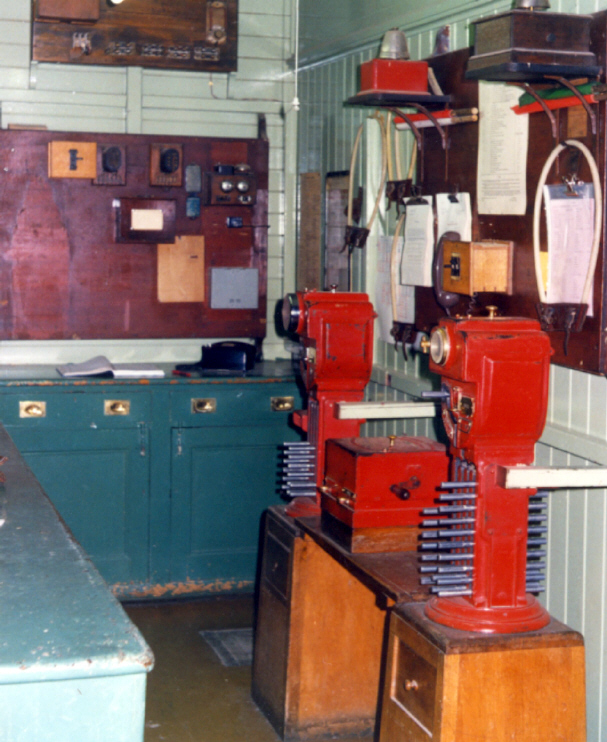
Electric staff instruments at Woomelang on their last day of use - 18-3-1989. The instrument on the left is Woomelang to Speed and on the right, Woomelang to Birchip. Photo: George Cullen
A new system of Train Order Working was introduced between Dunolly and Mildura from 19-3-1989 and the electric staff system from Birchip to Speed was abolished. Woomelang was established as a Train Order crossing station.
On 21-6-1989, all fixed signals and plunger locking was abolished. Trailable facing points set for left hand running and Location Boards were provided at each end. Non-trailable point machines and rodded connections were provided for the crossover at the Up end and for the turnout, derail and crowder at the Down end for movements between Nos. 2 and 3 tracks.
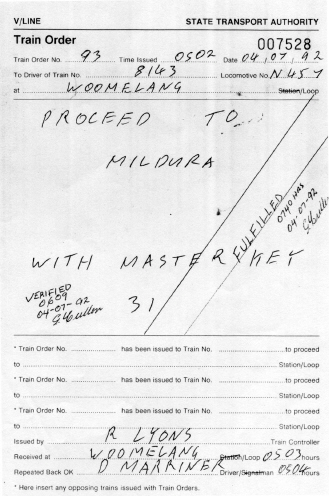
Train Order issued on 4-7-1992 to the driver of N457 on "The Vinelander" giving authority to proceed from Woomelang to Mildura. The order was issued at 5.02 a.m. at Woomelang and was verified at 6.09 a.m. by the changeover driver at Ouyen and signed off as fulfilled at 7.40 a.m. at Mildura. Source: Bruce McLean Collection
Section Authority Working replaced Train Order Working along the Mildura corridor, the first section from Maryborough to Donald on 21-9-1997 and second section from Donald to Yelta on 12-10-1997 with the section Woomelang - Gama Block Point.
Freight Victoria reintroduced Train Order Working from 25-7-1999. Woomelang was described as an Unattended Crossing Loop and named Woomelang Loop with the sections Curyo Block Point - Woomelang Loop; Woomelang Loop - Gama Block Point.
Woomelang Signalling Diagrams (Click on title to open file)
LASCELLES
Lascelles was opened with the Woomelang - Hattah section on 15-1-1903 as Minapre under no one in charge conditions. A loop siding was provided. The station was renamed Lascelles on 15-5-1905 and limit boards were provided by 4-9-1905. On 24-11-1909 a Caretaker was provided.
Up and down home signals and plunger locking were provided by 27-2-1911 and it is likely that the crossing loop was constructed at the same time and Lascelles was opened as a staff station with the staff sections Woomelang - Lascelles; Lascelles - Ouyen.
Large electric staff in lieu of train staff and ticket for the sections Woomelang - Lascelles and Lascelles - Speed were in place on 13-1-1915. The telegraph instrument was removed by 16-5-1922. A staff exchange box was installed by 6-10-1931. On 15-7-1948 No 2 Road was extended at the Down end and the up home signal was moved 247 yards further out.
Miniature electric staff replaced the large electric staff for the Woomelang - Lascelles; Lascelles - Speed sections on 6-1-1957.
A light home signal was provided in connection with the installation of flashing lights at the Henty Highway level crossing at the up end on 4-2-1969. The down home signal was moved 250 feet further out on 20-2-1969. The telegraph instrument was removed by 1-4-1969.
Lascelles was disestablished as an electric staff station on 30-6-1982 and the sections Woomelang - Lascelles and Lascelles - Speed replaced by the section Woomelang - Speed. Lascelles could be opened as an intermediate composite electric staff block post. These arrangements were altered on 13-12-1982 to include the condition that it may only open when Gama is not open. With the closure of Lascelles as a staff station, both Up and Down home signals were abolished and No.2 road was removed. Annett locks were provided on points in lieu of plunger locks with the keys held in Staff/Annett Key exchange apparatus to prevent unnecessary operation of the flashing lights at Henty Highway.
Large in lieu of miniature staff locks were provided on 7-3-1989 with Master Keys at Donald and Ouyen.
Train Order Working from Dunolly to Mildura commenced from 19-3-1989 and Lascelles was disestablished as an intermediate composite electric staff block post.
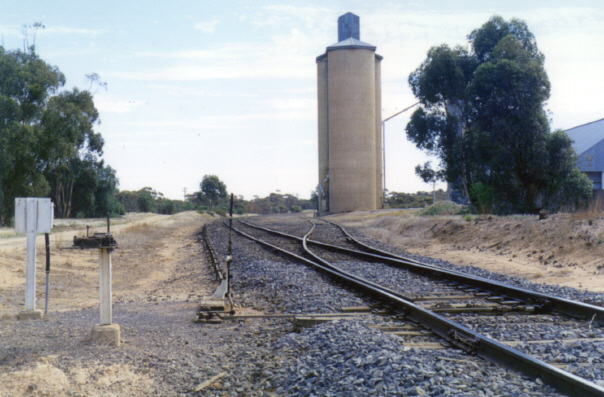
The Up end as Lascelles showing the Large Master Key/Annett Key exchange apparatus. 20-4-2002. Photo: Bruce McLean
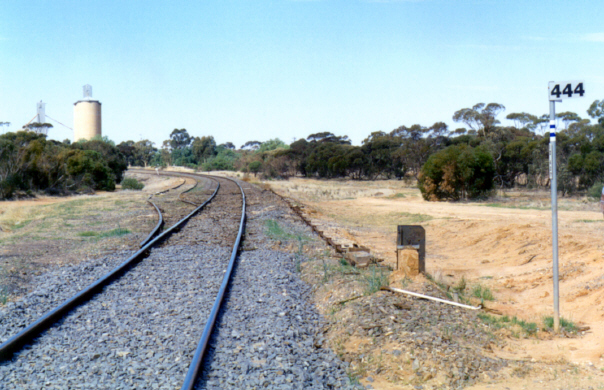
The down end of Lascelles following derailment damage on 19-1-2002. The points and associated safeworking equipment were damaged and removed pending conversion to standard gauge. 20-4-2002. Photo: Bruce McLean
Lascelles Signalling Diagrams (Click on title to open file)
GAMA
Gama was open for traffic under no one in charge conditions with the Woomelang - Hattah section with a loop siding. Limit Boards were provided by 4-9-1905.
Staff locks, unlocked by the train staff for the Lascelles - Ouyen section, were provided for the siding points on 22-2-1911, but derails in the siding were not provided until 19-12.1912. The Location (Limit) Boards were removed on 1-11-1922.
Large electric staff working for the section Lascelles - Speed was introduced from 18-1-1915, to be replaced by Miniature Electric Staff on 6-1-1957. Gama was closed to passengers from 1-2-1970. From 13-12-1982, Gama could be opened as an intermediate composite staff block post for the Woomelang- Speed electric staff section when Lascelles was not open.
On 7-3-1989 large in lieu of miniature staff locks were provided with Master Keys at Donald and Ouyen.
With the introduction of Train Order Working between Dunolly and Mildura on 19-3-1989, Gama was disestablished as an intermediate composite staff block post.
A Block Point was established on 25-2-92 at 414.850 km (about a kilometre on the up side of Gama) with the sections Woomelang - Gama Block Point; Gama Block Point - Speed Loop. Electronic end of train detection and location boards were also provided. The Train Order Section Woomelang - Speed was abolished.
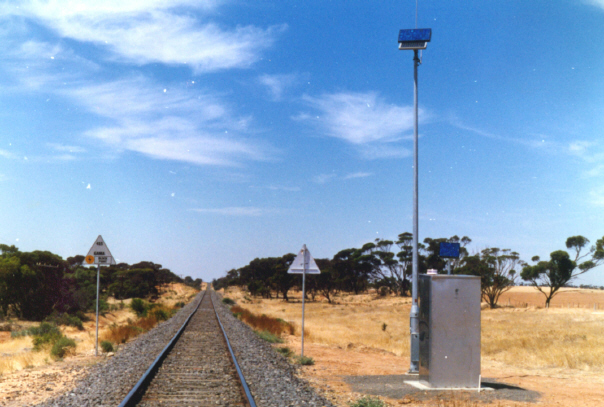
Gama Block Point looking in the up direction. 7-3-1992. Photo: Bruce McLean
Section Authority Working replaced Train Order Working between Donald and Mildura on 12-10-1997 with Gama remaining a Block Point.
Freight Victoria reintroduced Train Order Working from 25-7-1999. Gama was described as a Block Point Location with the sections Woomelang Loop - Gama Block Point; Gama Block Point - Speed Loop.
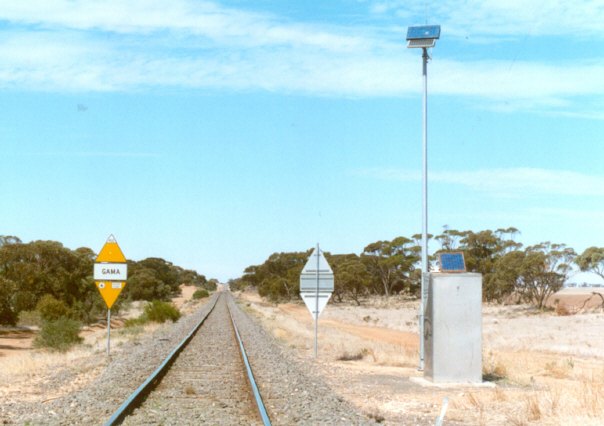
Gama Block Point looking in the up direction. Note the altered signage. 20-4-2002. Photo: Bruce McLean
Gama Signalling Diagrams (Click on title to open file)
TORPEY'S SIDING
Torpey's Siding was opened by 3-4-23. A short loop siding was provided with the main line points secured by large staff locks and rodded to derails. The large staff locks were replaced by miniature locks on 6.1.57.
The staff locks and siding were abolished on 19-10-1964.
Torpey's Siding Signalling Diagrams (Click on title to open file)
TURRIFF
Gorya was the name given to a temporary stopping place located 50 miles before the Hattah terminus when the line was opened to Hattah on 15-1-1903. It was a staff station for use by ballast trains during the construction of the line to Mildura.
Gorya was opened for all traffic on 8-8-1905 under no one in charge conditions. Limit boards were provided and there were staff locks on the siding points.
The name was changed from Gorya to Turriff on 11-6-1906.
Rodded derails were provided in the siding on 19-12-1912.
By 8-2-1915 a Caretaker was provided and the limit or location boards were removed by 1-11-1922.
The large electric staff locks were replaced by miniature electric staff locks on 6-1-57.
Turriff was operated under no one in charge conditions by 3-4-1973 and was closed to passenger traffic on 10-11-1975.
Large in lieu of miniature staff locks were provided on the staff locked points on 6-3-1989 with Master Keys kept at Donald and Ouyen.
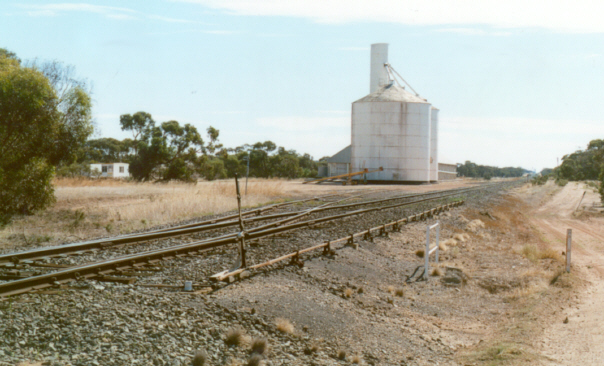
The up end of Turriff. The points are secured by a large master key. 20-4-2002. Photo: Bruce McLean
Turriff Signalling Diagrams (Click on title to open file)
SPEED
Speed was probably opened for traffic on 19-12-1906 when the staff locked siding was provided. It was originally known as 105 miles local and was named `Speed' on 1-5-1907. A loop siding with staff locks on the siding points was provided.
Speed was established as a Train Staff and Ticket station by 16-12-1912 with the sections Lascelles - Speed and Speed - Ouyen. Up and Down home signals were provided on 19-12-1912 and the points were changed to plunger locked in lieu of staff locked. No. 2 road was most likely provided at this time as a crossing loop.
On 13-1-1915 Large electric staff working was introduced between Lascelles and Speed and Miniature electric staff working by 4-10-1915 between Speed and Ouyen. A composite electric staff was provided by 4-1-1927 to enable Bronzewing to be opened as an intermediate electric staff block post. By 6-10-1931 a Staff Exchange Box was installed. It was a special type with a hinged lid secured by a padlock as it was necessary to exhange a Large Electric Staff for a Miniature Electric Staff (or vice versa).
On 6-1-1957 the large electric staff was replaced by a miniature electric staff for the section Lascelles - Speed and a standard Miniature Staff Exchange Box was provided.
The crossing loop was extended on 8-12-1960. The down home signal was moved 200 yards further out and the up end plunger locked points were moved 260 yards further out. The dead end extension at the down end of No.2 road was abolished.
A radio communication repeater tower was installed at the station in early 1984.
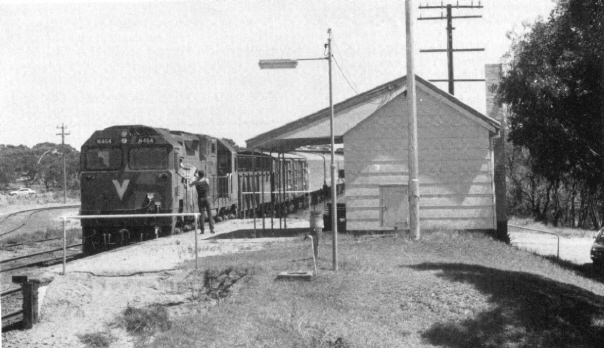
The electric staff is exchanged at Speed as N464 passes through on the Up "The Sunraysia" passenger train. 12-12-1988. Photo: Gavin McLaughlan
Train Order Working was introduced between Dunolly and Mildura on 19-3-1989 and the electric staff sections to Woomelang and Ouyen were abolished. Speed was then established as a Train Order crossing station.
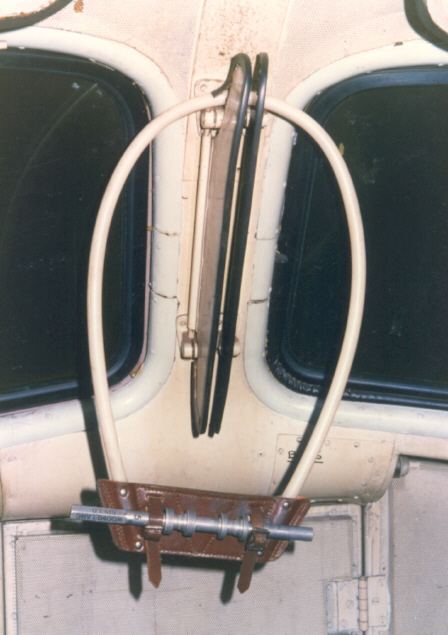
Speed to Woomelang electric staff on last day of use - 18-3-1989 - on board a B Class locomotive. Photo: George Cullen
On 1-6-1989 the Up and Down Home Signals were abolished and trailable facing points were commissioned and brought into service at each end of the Crossing Loop. The Main Line trailable points were normally set for No. 1 track for Up trains and normally set for No.2 track for Down trains. Electronic End of Train Detection was commissioned on 3-11-1989.
By 31-7-1990, a Hand Locking Bar and padlock was provided at the Down end points leading from No.2 to No. 3 tracks.
In connection with the introduction of Train Order Working in 1992, Speed became known as Speed Loop, the sections being Gama Block Point - Speed Loop; Speed Loop - Ouyen.
On 12-10-1997, an Assessment of Section Authority Working commenced between Donald and Yelta, replacing Train Order Working. The sections were Gama Block Point - Speed; Speed - Ouyen.
On 25-7-1999 Freight Victoria re-introduced Train Order Working and Speed Loop became an Unattended Crossing Loop with the sections Gama Block Point - Speed Loop; Speed Loop - Ouyen.
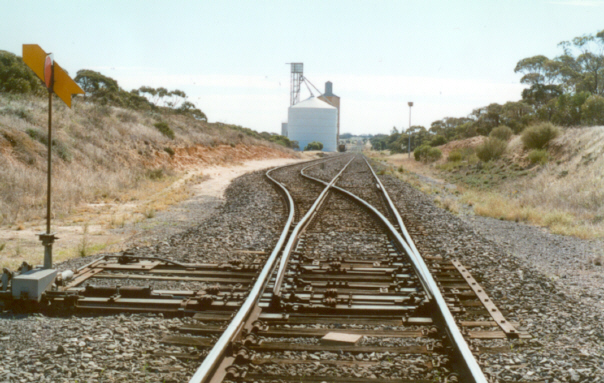
The up end of Speed showing the trailable points and directional indicator. 20-4-2002. Photo: Bruce McLean
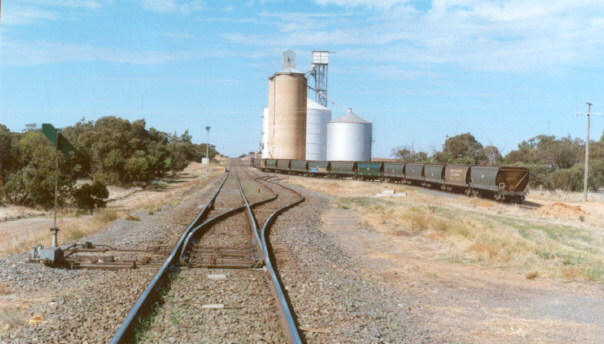
The down end of Speed looking in the up direction. 20-4-2002. Photo: Bruce McLean
Speed Signalling Diagrams (Click on title to open file)
TEMPY
Tempy was opened for traffic on 24-12-1908 with a loop siding and staff locked points. Rodded derails were provided in the siding on 19-12-1912.
On 1-7-1912 a Caretaker was provided and a Stationmaster was appointed on 15-4-1918.
The telegraph instrument was removed by 16-5-1922 and the location boards were removed on 1-11-1922. The Large Staff Locks were replaced by Miniature Staff Locks on 18-5-1926.
On 15-6-1931 the Class 9 Stationmaster was removed and Tempy reverted to Caretaker conditions.
The Down end Staff Locked points were removed 46 metres further out on 28-11-1977 to provide an extended siding.
No one in charge conditions prevailed by 20-3-1979.
Tempy closed for passenger traffic by 5-10-1982.
Large in lieu of miniature staff locks were provided on 3-3-1989 with Master Keys at Donald and Ouyen.
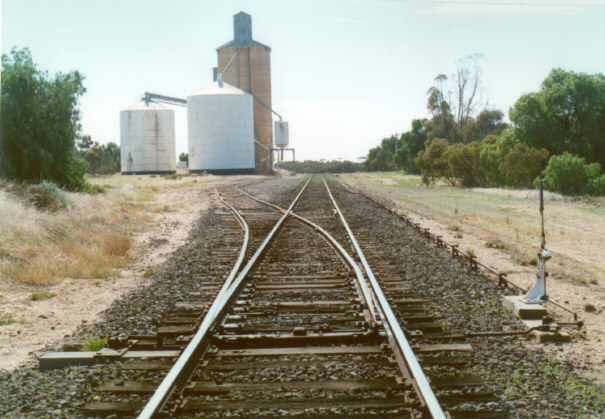
The up end of Tempy looking in the down direction. 20-4-2002. Photo: Bruce McLean
Tempy Signalling Diagrams (Click on title to open file)
GYPSUM
Gypsum was opened by 7-9-1903 as Austral Gypsum Siding after the Austral Gypsum Co. requested a siding at 274 miles on 22-6-1903. The site had been used as a ballast siding. The siding was ready for use by 13-8-1903 with an annual licence fee of one pound from 1-3-1904.
The main line points were secured by Staff Locks from 2-3-1904.
Limit Boards were erected by 4-9-1905 as there were no signals.
On 12-9-1911, the siding became the property of the Commissioners as Austral Gypsum Co. had discontinued operations.
The siding was fitted with rodded derails on 19-12-1912. The siding was opened for inwards goods in truck loads of 2 tons minimum in 1914.
The siding was extended and a goods platform provided by 3-12-1920.
Austral Gypsum Siding was renamed Gypsum Siding on 30-5-1921 and it was likely that a passenger platform was provided at this time as a January 1921 newspaper report indicated that there was activity at the siding necessitating a speed restriction.
The Location Boards were removed by 1-11-1922.
The Large Staff Locks were replaced by Miniature Staff Locks on 18-5-1926.
On 15-9-1927 the named was shortened to Gypsum.
The siding was closed to all traffic on 1-1-1955.
Gypsum Signalling Diagrams (Click on title to open file)
BRONZEWING
Bronzewing was opened on 16-2-1921 as Boulka. The main line points were secured by plunger locks and up and down home signals were provided. In March 1921 the points were secured by staff locks. The plunger locks and home signals were placed out of use.
By 5-4-1921 Boulka was established as an electric staff station with the sections Speed - Boulka and Boulka - Ouyen. The plunger locks and home signals were brought into use and the staff locks taken out of use but retained. The station was open for passenger and goods traffic on 26-4-1921 but by 19-7-1921 it was disestablished as an electric staff station and worked under no one in charge conditions by 2-8-1921.
On 1-11-1921 Boulka was renamed Bronzewing.
Bronzewing was temporarily established as an electric staff station for crossing trains with the sections Speed - Bronzewing and Bronzewing - Ouyen during the wheat seasons of 1922, 1923, 1924, and 1925 before being established as an intermediate composite staff block post in the section Speed - Ouyen by 4-1-1927. While open as a staff station the home signals and plunger locks were in use. At other times the points were secured by staff locks.
The electric staff instrument was removed by 28-4-1936, the up and down home signals were removed and the plunger locking removed by 12-5-1936, and No.2 road was removed by 8-4-1941.
Bronzewing was closed to all traffic on 3-6-1963 and the siding abolished, the staff locked points being removed on 1-10-1963.
With the commencement of Train Order Working between Dunolly and Mildura on 19-3-1989, Bronzewing was disestablished as an intermediate composite staff block post.
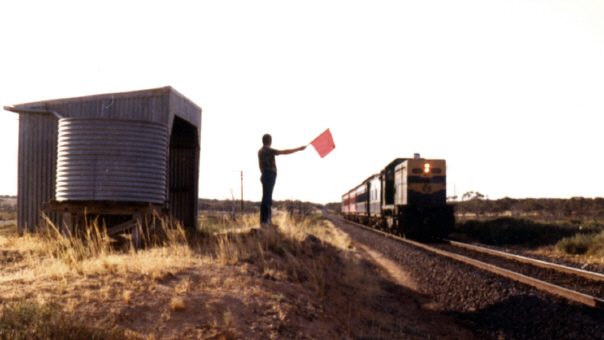
The power of a red flag! The author is silhouetted against the morning sun at 8.02 a.m. as he holds a red flag to stop a railway enthusiast special train at the site of Bronzewing station on 30-12-1981. Photo: John R. Page
Bronzewing Signalling Diagrams (Click on title to open file)
NUNGA
Nunga was also named Boulka when it first opened on 30-1-1912 with staff locks on the loop siding and under no one in charge conditions. It was renamed Nunga on 9-12-1912.
Location boards were removed on 1-11-1922 and by 2-12-1924 Nunga was provided with a Caretaker.
Miniature staff locks replaced the Large staff locks on 18-5-1926. The Caretaker was withdrawn on 4-11-1929. Large in lieu of miniature staff locks were provided on the staff locked points on 3-3-1989 with the Master Keys kept at Donald and Ouyen.
Nunga Signalling Diagrams (Click on title to open file)
OUYEN
Ouyen was opened with the Woomelang to Hattah section on 15-1-1903. A simple loop siding was probably provided. No one was in charge of the station.
Limit Boards were provided by 4-9-1905 and staff locks on the main line points were provided on 21-5-1909 with the key being the train staff for the Woomelang - Mildura section.
Ouyen was established as a Train Staff and Ticket station by 28-6-1909 with the sections Woomelang - Ouyen and Ouyen - Mildura. The location boards and staff locks were removed and up and down home signals were provided on 26-6-1909.
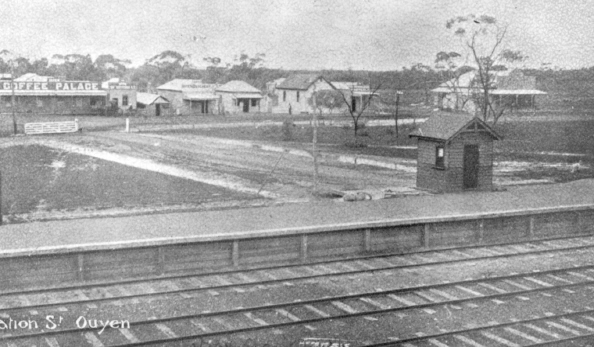
Ouyen in 1909. The building on the platform was provided to house the signal lever frame following the provision of Up and Down home signals on the main line and an Up home signal on the new branch line under construction to Kow Plains. Note the buildings on the eastern side of the railway along Farrell Street (Calder Highway). Photo: Victorian Railways
The Railway Construction Branch commenced construction of the Kow Plains line on 11-1-1909 and an up home signal was provided on the new branch line for construction trains on 24-5-1911. Plunger locks provided on the main line points on the same day. The line to Murrayville was open for traffic on 25-6-1912.
The up home signal was moved 220 yards further out by 25-11-1912.
A 53 foot turntable was provided by 31-3-1913. The points in the Murrayville line were provided with a plunger lock on 7-5-1913 and a disc signal provided to control moves from the loco roads to the yard. These arrangements were altered by 26-4-1915 when the points to the loco roads were secured by an Annett lock. The disc signal was abolished and a new down home signal provided to protect the points to the loco roads. A five lever interlocking frame was provided on the platform to work the signals.
Electric staff working replaced Train Staff and Ticket by 4-10-1915 with the sections Speed - Ouyen and Ouyen - Hattah.
The points leading to the Pintsch Gas siding were secured by an annett lock on 17-6-1920.
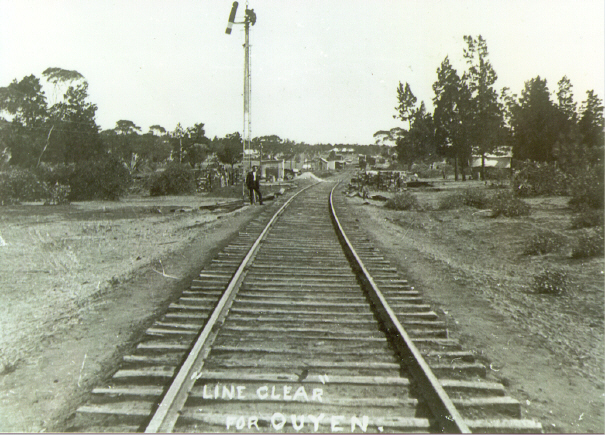
Ouyen circa 1910 looking in the up direction. The up home signal and the number of tracks in the yard indicate that construction of the Murrayville line had commenced. Source: Ouyen Local History Resource Centre Collection
In connection with the establishment of a new locomotive depot adjacent to the Murrayville branch line, a number of alterations were made. A 70 foot turntable was provided by 3-8-1926 replacing the 53 foot turntable at the old loco depotl. The rails from the original locomotive depot sidings were used to construct two dead end sidings at the down end of No 2 Road. These were brought into use on 4-11-1926 in conjunction with a new annett locked crossover between Nos 1 and 2 Roads. The down departure home signal was relocated to be clear of this new crossover.
The up home signal for the Murrayville line was placed 100 yards further out on 20-7-1927.
The connection to the new locomotive depot was secured by an annett lock on 27-7-1927 and a down departure home signal was provided on the branch line to protect it. A new 10 lever interlocking frame was provided on the platform replacing the 5 lever frame.
A composite electric staff was provided in the Ouyen - Hattah section by 30-10-1928 to allow Kiamal to be opened as a composite electric staff block post.
On 7-11-1933 the up home signal was moved 140 yards further out.
By 17-4-1934 the selector telephone system was extended from Birchip to Ouyen. Trains between Maryborough and Ouyen were now controlled by Train Control.
There were major alterations to the up end of the yard in 1939. The up home signal on the branch line was moved 480 yards further out on 5-9-1939, and on 6-9-1939, the crossover from No.1 road to the branch line was replaced by a new connection on the Up side of the level crossing. The junction points were secured by a plunger lock and a bracket post was provided with departure home signals for the main and branch lines. The annett lock and associated home signal was removed from the points to the loco depot
The double compound in the main line providing access to the works siding (the original loco depot) was replaced by two simple turnouts on 17-12-1942.. A 1500 foot dead end extension was provided at the Down end of No.4 road on 23-12-1942. The turntable disc was abolished by 5-3-1946.
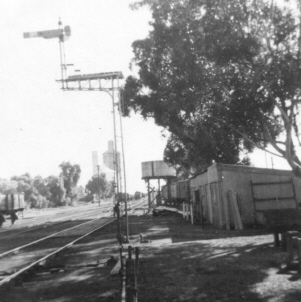
The down home departure signal at Ouyen, 1966. Photo: Unknown, Bruce McLean Collection
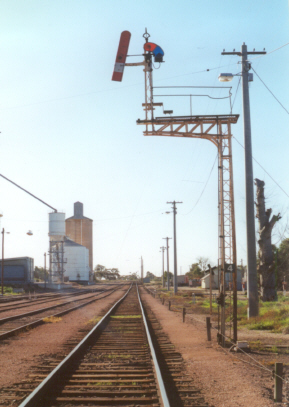
The same signal on 16-7-2000. Photo: Bruce McLean

The down departure signal at Ouyen looking in the up direction towards the platform and car siding .20-7-1986. Photo: Bruce McLean
The turntable was removed by 2-12-1969. After the locomotive depot was closed, the siding was used to serve the stockyards.
The level crossing at the up end of the station for the Ouyen Highway was provided with flashing lights on 11-10-1973 and the home signals on the bracket post were converted to light s.
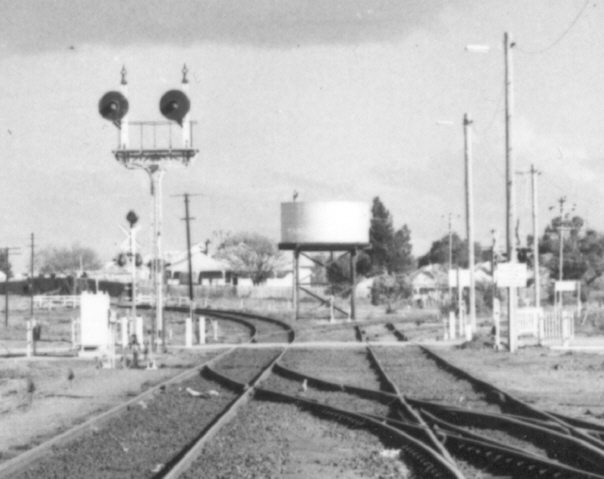
Electrically lit color light signals on the bracket post at Ouyen junction. 18-8-1979. Photo: Bruce McLean
The Down Home Arrival Signal was electrically lit on 22-11-1979.
Hand Locking Bars and padlocks were provided to protect the loading area of the Ouyen Freight Centre by 12-2-1980. They were placed at the points on the Up and Down ends of No.6 Shed Track.
On 29-9-1982, Flashing Light signals were installed at the William Street level crossing at the down end of the station. A new two position Down Light Signal, Post No.5, was provided on the Up side of the roadway. The Up Home Semaphore Signal No.2 was abolished and replaced in lieu by a two position Light Signal, Post No.6, which is repeated to the Signal Box. The home signal on Post No. 4 was electrically lit.
Flashing Light signals were brought into service at the Ouyen Highway level crossing on the branch line at 467.575 km on 14-10-1982.
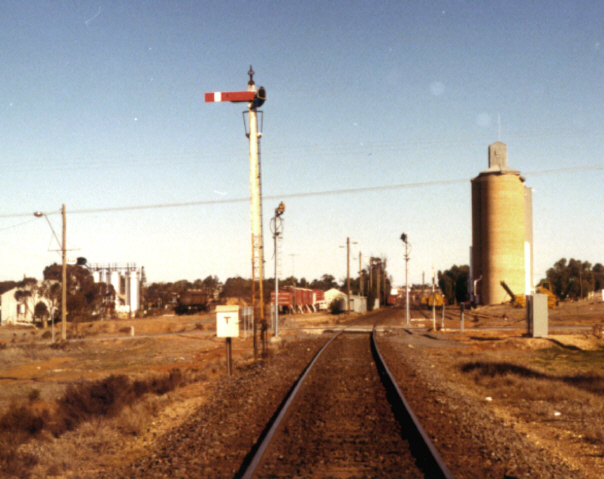
Down home signal at Ouyen shortly before removal and replacement with color light signalling in connection with flashing light signals at the William Street level crossing. Note the new signal posts each side of the level crossing. 16-8-1982. Photo: Bruce McLean
A radio communication repeater tower was installed at the station in early 1984.
The Electric Staff system between Ouyen -Hattah - Carwarp - Redcliffs was replaced by Train Staff and Ticket working with the single long section Ouyen - Redcliffs on 27-2-1987 between Friday and Monday. On weekdays the Electric Staff system continued in use. Train No. 224 from Mildura at 1.30 p.m. on Friday 27-3-1987 was the first train to run under the special Train Staff and Ticket working between Redcliffs and Ouyen, running from Redcliffs to Ouyen on a Ticket.
An extended crossing loop was provided on 20-8-1987. A new set of plunger locked points were provided on the main line at the Down end on 20-8-1987 with a quadrant lever and Annett lock. A switch was provided at the new points to operate the down departure home signal.
The hinged Hayes type derail at the down end of No.6 track was relocated to the fouling point on the dead end extension to No.6 track on 15-8-1988.
The Murrayville line junction was rationalised on 7-12-1988. The connection from No 1 Track to the Murrayville line was abolished and the right hand arm on the bracket post was removed. The plunger locked connection from the main line to the yard was relocated to the up side of the level crossing. The stockyard siding (former loco depot) was abolished.
The plunger lock at the down end points were replaced by trailable points set for No.1 track on 7-3-1989.
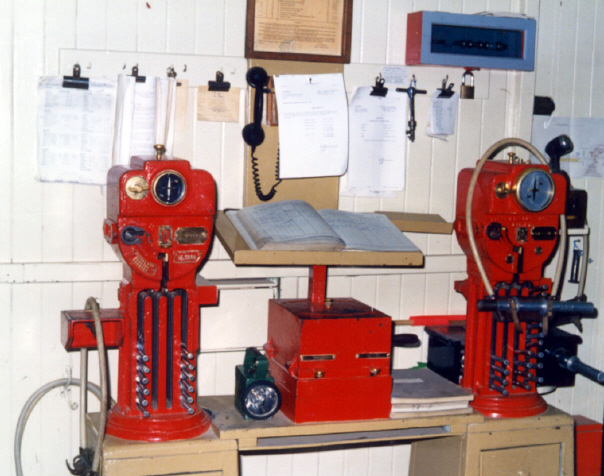
Electric staff instruments at Ouyen on the last day of use - 18-3-1989. Ouyen to Hattah on left and Ouyen to Speed on right. Photo: George Cullen

Ouyen to Hattah electric staff. Photo: Bruce McLean
On 19-3-1989 Train Order Working was introduced between Dunolly and Mildura and the electric staff working to Speed and Hattah was abolished. Ouyen was established as an Intermediate Train Order Terminal station and the special weekend Train Staff and Ticket arrangements cancelled. By 11-4-1989 Train Orders could be issued through Ouyen for specified trains.
Electronic end of train detection (TAILS) was commissioned on 3-11-1989, but the equipment at the up end was abolished on 25-10-1991.
A new radio system commenced operation in 1993 with Ouyen becoming an "all persons must carry a radio location". Every person desiring entry to the yard for visiting, maintenance or other purposes was required to report to the Officer-in-Charge to make the necessary radio arrangements.
By 15-3-1994, Ouyen was worked with no one in charge for certain trains.
With the introduction of Section Authority Working on 12-10-1997 Ouyen remained as an Intermediate Terminal Station.
Operational staff were withdrawn from 1-5-1999 following the purchase of V/Line Freight by Freight Victoria leaving Ouyen without staff for shunting and signalling.
On 25-7-1999 Freight Victoria re-introduced Train Order Working and Ouyen reverted to an Intermediate Terminal Station with the sections Speed Loop - Ouyen; Ouyen - Hattah Block Point. A signaller was required to be in attendance when a train was to be routed to the Panitya branch line from the main line or arrives off the Panitya branch line; No.2 track is to be fouled within the station yard; or trains are to cross at Ouyen utilising Nos.1 and 2 tracks ain the station yard.
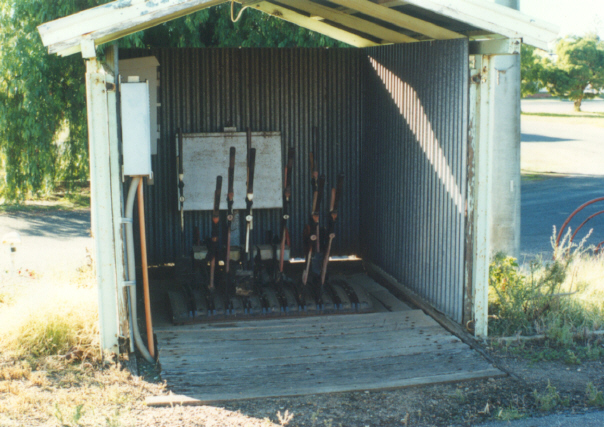
The signal frame and housing on the platform at Ouyen. 24-4-2000. Photo: Bruce McLean
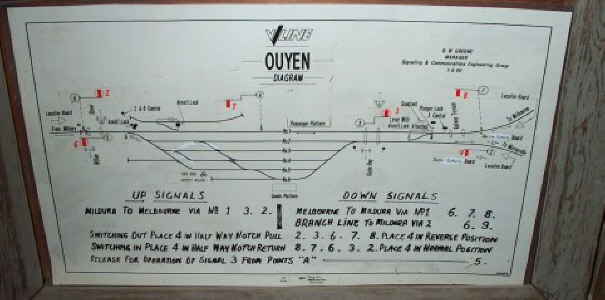
Diagram for Ouyen signal frame, amended to March 1980. 24-4-2000. Photo: Bruce McLean
Ouyen Signalling Diagrams (Click on title to open file)
| << Back | Home | Site Map | Copyright © 2003 Bruce McLean, All Rights Reserved |